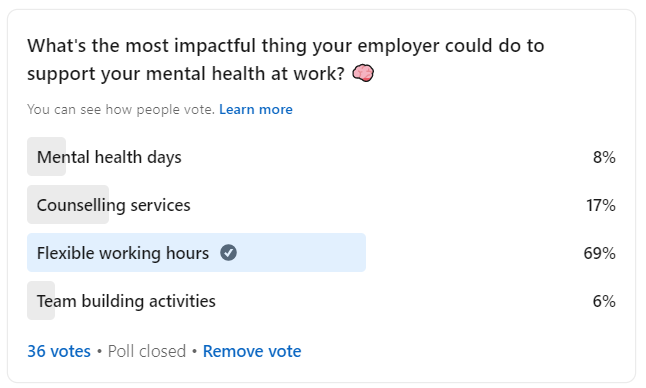In a recent poll we asked you to choose the most impactful thing employers can do to improve mental health in the workplace… these were the results:

Out of the 36 individuals who responded to the poll, it was recognized that while team-building activities, counseling services, and mental health days are all relevant when it comes to supporting employee mental health, by far, offering flexible working hours received a landslide of support – this begs the question…. why? In this blog, we take a deeper look into the many benefits of offering flexible working hours, how this has had a positive impact on our own employees at WM, and how firms can successfully implement this increased flexibility into their business.
Benefits of Flexible Working Hours
While it has become clear that the demand has not changed for continued flexible working hours, we can now observe the various effects that have emerged from granting employees this opportunity, both in the short and long term. As an employer, there are a host of benefits that come with the increased flexibility including improved retention and overall employee well-being, which has been linked to an increase in performance by 13%, a 90% increase in morale, and improved mental health. We explain in detail some of these benefits below.
Enhanced Work-Life Balance: Flexible schedules empower your employees to better manage personal commitments whilst meeting work responsibilities.
Reduced Stress-Levels: By offering flexibility, you are building a supportive environment that enables a healthier work-life integration – with one study showing a 25% reduction in stress levels.
Increased Productivity: When employees have the freedom to choose their optimal working hours, they can align their tasks with their energy levels, resulting in increased efficiency.
Talent Attraction & Retention: 78% of HR Professionals surveyed by Crain’s Future of Work survey say flexible schedules and remote working are effective ways to retain workers without spending money. Leverage your flexibility initiatives as a unique selling point in your recruitment efforts, showcasing your company as a progressive and employee-centric firm.
It is hard to ignore the significance of the benefits that come with allowing a more flexible work environment; however, problems can arise when firms attempt the transition without careful consideration – so here are some key points to consider when implementing flexible working hours.
Implementation
Establish Clear Guidelines: Clearly communicate expectations, core working hours, and how employees should coordinate with their teams to ensure smooth collaboration. Achieving successful flexibility requires alignment and shared goals among all team members. Improper management of flexibility can negatively impact productivity, resulting in employees either working excessively or insufficiently or being unavailable when needed. Effective communication is essential in addressing this issue. It is crucial to establish clear expectations regarding the availability of employees for meetings, whilst allowing flexibility outside of these designated timeframes. This approach is particularly relevant for a firm like White Marble, where collaboration with clients adhering to more traditional schedules is common. Therefore, it is important to prioritise their schedules and ensure timely responsiveness to their needs. This sense of collaboration is embedded into White Marble’s DNA. Our weekly company-wide meetings, regardless of independent schedules, are a great opportunity for everyone to come together and voice their views, opinions, or share projects they’re working on or are passionate about. It enhances a sense of comradery between the team and allows for relationship-building regardless of differing hours and roles within the company.
Leverage Technology: Utilise collaboration tools, project management software, and time-tracking apps to facilitate communication and accountability among your remote or flexible workforce. For example, here at White Marble we are able to collaborate through Trello – a visual web tool that allows the team to manage any type of project, workflow, or task tracking. We’re able to remotely, yet clearly see a project status, which we further track in our Productive dashboards – which allows further oversight on project time and prioritisation This is just a couple of the many tools present; their purposes ranging all with impressive capabilities and untapped potential.
Offer a Trial Period: Diving in headfirst without a trial run can result in a few speed bumps. It makes sense to begin with a pilot program or trial period to assess the impact and fine-tune the implementation before rolling it out company wide. We introduced Trello to our employees for a trial period, and then reached out with a survey to receive feedback on whether or whether not to continue using it. However Productive was implemented in September of 2022, where we didn’t utilise a trial period, but rather we offered the chance for employees to vote on their preferred method of time and project tracking.
Conclusion
Can flexible working hours succeed in improving employee mental health? It seems so! The poll results indicate the willingness of our community to try and build on a new system of work, one that best supports employees and indirectly businesses – flexible working hours seems to bolster both.
Source: Flexible Work Statistics And Trends in 2023 • GITNUX